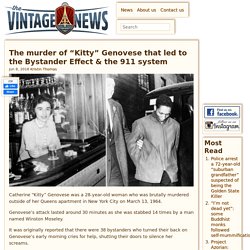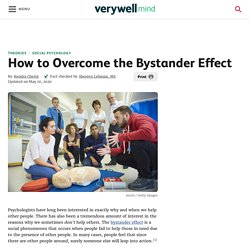

Bystander effect – APA Dictionary of Psychology. What Is the Bystander Effect? If you witnessed an emergency happening right before your eyes, you would certainly take some sort of action to help the person in trouble, right?

While we might all like to believe that this is true, psychologists suggest that whether or not you intervene might depend upon the number of other witnesses present. What Is the Bystander Effect? The term bystander effect refers to the phenomenon in which the greater the number of people present, the less likely people are to help a person in distress. When an emergency situation occurs, observers are more likely to take action if there are few or no other witnesses. Being part of a large crowd makes it so no single person has to take responsibility for an action (or inaction). What Is the Bystander Effect? THE BYSTANDER EFFECT. The bystander effect - Economic and Social Research Council. Bystander Effect - Definition, Examples and Experiment. Bystander effect. The murder of "Kitty" Genovese that led to the Bystander Effect & the 911 system.
Catherine “Kitty” Genovese was a 28-year-old woman who was brutally murdered outside of her Queens apartment in New York City on March 13, 1964.

Genovese’s attack lasted around 30 minutes as she was stabbed 14 times by a man named Winston Moseley. It was originally reported that there were 38 bystanders who turned their back on Genovese’s early morning cries for help, shutting their doors to silence her screams. Although that judgment was later proven to be inaccurate, the murder was considered the driving force behind our emergency 911 system today and the discovery of the term that so many psychologists are still researching: “The Bystander Effect.”
It was around 3 o’clock in the morning when Genovese arrived home from managing a local bar where she worked. Kitty Genovese She parked her car and started walking towards her apartment building, when she noticed a man standing at the corner end of the parking lot. Genovese nervously kept walking. Studio photo of Catherine “Kitty” Genovese, 28. Kitty Genovese Murder Case Analysis & The Bystander Effect. Bystander intervention in emergencies diffusion of responsibility. GarciaWeaverMoskowitzDarley2002. Bystander apathy. Pluralistic Ignorance in the Bystander E. Diffusion of Responsibility - Definition and Examples - One Mind Therapy.
Research on the Diffusion of Responsibility Many studies have looked at the bystander effect. John Darley and Bibb Latané were two of the first psychologists to develop a diffusion of responsibility experiment. Following the murder of Kitty Genovese in the late 1960’s, Latané and Darley conducted studies investigating the effect. In their first and most well-known study, they looked at the relationship between group size and reporting danger. Study participants were asked to fill out a questionnaire in a room that was slowly filling with smoke. An interesting finding is that the phenomenon impacts groups of only three people. Latané and Darley created a model of helping to describe the process through which individuals go before taking action. Noticing A bystander must first notice that an event is occurring. Utilizing the Diffusion of Responsibility Understanding this phenomenon can help us to take action as individuals and as a greater society. Explaining Social Inaction. Pluralistic Ignorance (SOCIAL PSYCHOLOGY) - iResearchNet.
Pluralistic Ignorance Definition Pluralistic ignorance occurs when people erroneously infer that they feel differently from their peers, even though they are behaving similarly.

As one example, imagine the following scenario: You are sitting in a large lecture hall listening to an especially complicated lecture. After many minutes of incomprehensible material, the lecturer pauses and asks if there are any questions. No hands go up. You look around the room. Another case of pluralistic ignorance that is familiar to many college students concerns drinking on campus. Pluralistic Ignorance and Social Dynamics Pluralistic ignorance plays a role in many other dysfunctional social dynamics. How to Overcome the Bystander Effect.
Psychologists have long been interested in exactly why and when we help other people.

There has also been a tremendous amount of interest in the reasons why we sometimes don't help others. The bystander effect is a social phenomenon that occurs when people fail to help those in need due to the presence of other people. In many cases, people feel that since there are other people around, surely someone else will leap into action.1 While the bystander effect can have a negative impact on prosocial behavior, altruism and heroism, researchers have identified a number of different factors that can help people overcome this tendency and increase the likelihood that they will engage in helping behaviors.2 Some of these include: Bystander Intervention. Center for Identity and Inclusion The Center for Identity and Inclusion, based in the downtown campus, supports underrepresented students and promotes a diverse and inclusive campus.

The CII’s work consists of the efforts and commitment from the American Indian Student Services (AISS), Asian American Student Services (AASS), Black Student Services (BSS), and Latinx Student Services (LSS). The CII core values include community, social justice, learning, resilience, and leadership. Physical Location: 1201 Larimer St. Suite 2007, Denver, CO 80204Phone: 303.315.1877Center for Identity and Inclusion Email: cii@ucdenver.edu Office of Diversity and Inclusion The Office of Diversity and Inclusion offers services, resources, and guidance to enhance diversity and foster a culture of inclusion for the CU Denver | CU Anschutz campuses. Physical Location: 1380 Lawrence Street, Denver, CO 80204Phone: 303.315.2123Office of Diversity and Inclusion Email: ODI@ucdenver.edu.
Active bystander. References.